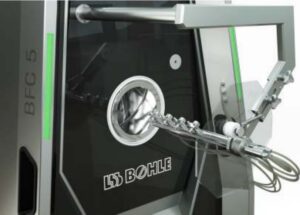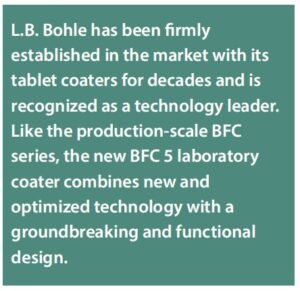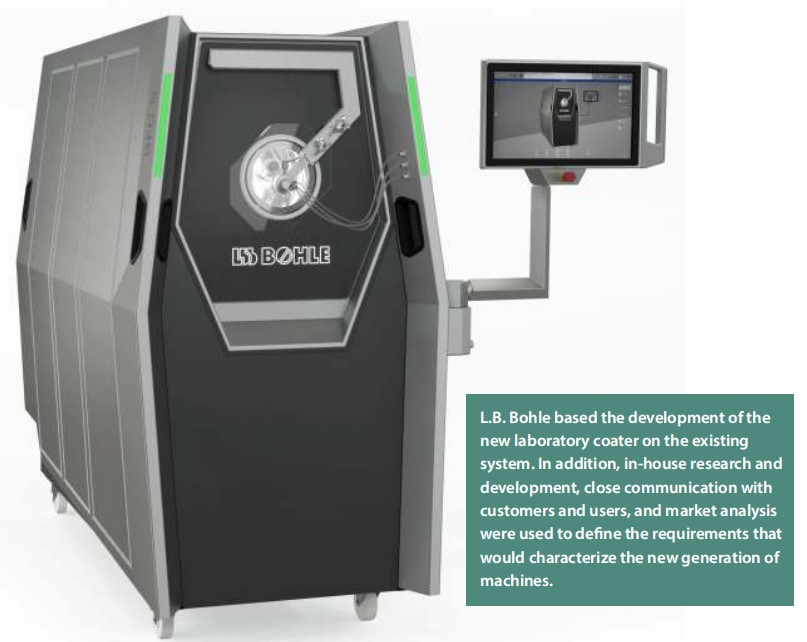COATING TABLETS
Getting the best results from the start
Rapid development and the best results right from the start are the goals of research and development departments in the pharmaceutical industry. This also applies to the tablet coating process.
Tablets are the most important oral dosage form in the pharmaceutical industry and are therefore produced in large quantities. In addition to efficacy and functionality, the size, color and shape of the tablet can influence the marketing of the drug.
Tablet coating is the application of a thin film of one or more polymers and other functional excipients (colorants or humectants) to the tablet, which can perform various functions. Tablets are coated to modify the release of the active ingredient, to protect the active ingredient from light or moisture, or to mask a bitter taste in the tablet formulation. Tablets are also coated to make them easier to swallow.
When developing formulations or optimizing products, an existing formulation is usually used first. Each coating is often based on an earlier formulation that is modified to improve the binding of the coating to the tablet core or to increase the hardness of the coating.
Drug Coating
Drug delivery systems are becoming increasingly important. This includes combination products as well as the combination of two incompatible active ingredients in one dosage form. In addition, different release profiles of the same active ingredient can be combined. The core contains the slow-release component and the tablet coating contains the fast-release initial dose. Formulation approaches sometimes consist of up to four different film types. This results in long process times. To successfully develop and produce such formulations, uniformity of the tablet coating is a mandatory requirement.
Coater design: the interplay of mixing, spraying and drying
The interplay of mixing, spraying and drying is critical in tablet coating. Mixing, spraying and drying must occur simultaneously and with the correct settings to achieve optimum coating uniformity.
Mixing
Smooth and gentle movement of the tablet cores under the spray cones is essential. The tablet cores must not be subjected to excessive mechanical stress to avoid damage.
 L.B. Bohle Maschinen und Verfahren GmbH (Ennigerloh, Germany) has been successfully using an extended coating drum (length diameter (L/D) > 1) with welded-in mixing spirals for more than 20 years. The mixing spirals ensure continuous and gentle mixing of the tablet bed. Homogeneous mixing is achieved within minutes and is maintained throughout the process. The flat tablet bed reduces the mass pressure in the tablet bed. The continuous guidance of the mixing spirals means that the tablets are not greatly accelerated. Tablet breakage and twinning do not occur.
L.B. Bohle Maschinen und Verfahren GmbH (Ennigerloh, Germany) has been successfully using an extended coating drum (length diameter (L/D) > 1) with welded-in mixing spirals for more than 20 years. The mixing spirals ensure continuous and gentle mixing of the tablet bed. Homogeneous mixing is achieved within minutes and is maintained throughout the process. The flat tablet bed reduces the mass pressure in the tablet bed. The continuous guidance of the mixing spirals means that the tablets are not greatly accelerated. Tablet breakage and twinning do not occur.
Drum geometry

 The drum geometry of the L.B. Bohle BFC tablet coater creates a large spray surface in the moving tablet bed. This means that more spray nozzles can be used than with shorter drums. This results in a larger spray area and higher spray throughput. In addition to the coating suspension, the nozzle type, number of nozzles and nozzle spacing are important.
The drum geometry of the L.B. Bohle BFC tablet coater creates a large spray surface in the moving tablet bed. This means that more spray nozzles can be used than with shorter drums. This results in a larger spray area and higher spray throughput. In addition to the coating suspension, the nozzle type, number of nozzles and nozzle spacing are important.
Typically, the amount of suspension mass in film-coated tablets is 5-15% of the core mass. Of particular importance is the film thickness, which is not only important for active ingredient coatings, but must also be uniform for thin color (protective) coatings. An uneven film application within a batch will result in color differences that reduce product quality.
Compared to conventional tablet coaters with L/D ratios <1, systems with extended drums enable up to 40% shorter process times due to higher spray rates.
Drying
It is critical to ensure optimal energy and mass transfer. This means that the energy must be introduced directly into the tablet bed. The air flows directly and quietly into the tablet bed and effectively ensures rapid drying of the sprayed suspension. The periphery of the coater or the housing is not heated.
Optimal airflow creates a smooth spray pattern that reduces spray drying. Spray nozzles are not exposed to the supply air stream and remain cool during the spraying process. This minimizes spray drying effects and achieves coating uniformity of >97% and better.
New lab-scale coater
L.B. Bohle has been firmly established in the market with its tablet coaters for decades and is recognized as a technology leader. At Achema 2024, the company presented the new BFC 5 laboratory coater. After L.B. Bohle presented a new production-scale tablet coater, the BFC 400, at Interpack 2023, a laboratory coater for batch sizes up to 13 liters followed.
Like the production-scale BFC series, the BFC 5 laboratory coater combines new and optimized technology with a groundbreaking and functional design.
L.B. Bohle based the development of the new laboratory coater on the existing system. In addition, in-house research and development, close communication with customers and users, and market analysis were used to define the requirements that would characterize the new generation of machines.
The BFC 5 laboratory coater is a flexible, mobile stand-alone machine. The entire air, electrical and control technology is integrated into the machine. The laboratory coater is operated conveniently and effectively via a multi-panel visualization with touch panel. The rotating control unit is located directly on the coater. Start-up is quick and easy, requiring only an electrical connection and a compressed air supply.
Flexibility for research and development
The BFC 5 laboratory coater can now be operated with a total of three different drum sizes – with the same drum geometry. The coater comes standard with two drums. This allows batch sizes (volume to edge in liters) of 2 to 6 liters or 5 to 13 liters. The smaller drum allows batches of 0.5 – 3 liters by using a separating disk. A trolley is included as standard for easy removal and transport of the drum.
All results obtained can then be safely scaled up to larger batches.
A new slotted mini drum for test or very small batches of 150 – 350 g now offers even more flexibility. The slotted drum has been perforated to accommodate not only normal-sized cores, but also extremely small cores as small as 1.5 millimeters in diameter.
This makes the small drum an effective and profitable addition, especially in product development and for cost-intensive active ingredients or formulations.
New nozzle arm with mini pump head
 L.B. Bohle relies on a modular solution for the nozzle arm: depending on the application, one to four nano nozzles from Schlick are used. Other laboratory coaters on the market sometimes have only one nozzle. Each nozzle is fed individually via a tubing pump head that holds all four tubings. This guarantees a homogeneous and reproducible spray result. Thanks to the anti-bearding caps (ABC), there is no product build-up.
L.B. Bohle relies on a modular solution for the nozzle arm: depending on the application, one to four nano nozzles from Schlick are used. Other laboratory coaters on the market sometimes have only one nozzle. Each nozzle is fed individually via a tubing pump head that holds all four tubings. This guarantees a homogeneous and reproducible spray result. Thanks to the anti-bearding caps (ABC), there is no product build-up.
Operator focus - improved accessibility and cleaning
With the new system, L.B. Bohle’s designers placed great emphasis on improved accessibility to the process area and sensors. This is now ensured by an enlarged door.
Two status lights integrated into the machine design give the operator an overview of the machine’s status at all times.
Cleaning of the laboratory coater has also been improved. Three cleaning nozzles now ensure that the entire surface is completely wetted and cleaned. A new level sensor prevents overfilling.
The pressure control for forming and atomizing air is now integrated into the software as standard, instead of being manually adjustable. This ensures process accuracy and minimizes variation.

